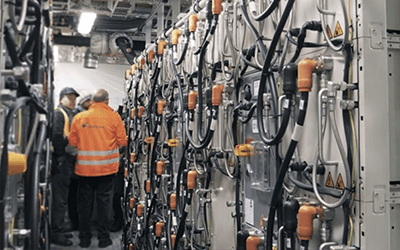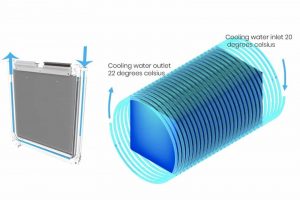
Written by Brent Perry, CEO, SPBES
Published in ShipInsight, see link for article here.
The shipping industry is currently finding itself at a vital transition point with respect to creating a more sustainable future, and with it, embracing the opportunity of lithium-ion technology as an increasingly viable energy storage solution.
Just by looking at the increasing prevalence of the electric and hybrid vessels as a barometer for pace of change, it is indeed a promising future for the lithium ion energy storage system (ESS). The cruise and ferry industry are increasingly looking to lithium-ion batteries as ESS within their electric-hybrid vessels. This is especially true in Norway, where regulators and owners are leading attempts in adopting electric shipping to power the hundreds of cruise and ferry routes to make the fjords a carbon-neutral zone.
The recent fire on board the Norwegian ferry, Ytterøyningen, however, has brought the safety issue of batteries at sea into focus. As with any new propulsion technology, it is essential that the industry understands the best practices that go with managing risks and how design, installation and operation of batteries can ensure that they are safe.
Preventing Thermal Runaway
The biggest risk surrounding the lithium-ion ESS is thermal runaway. This manifests as a positive feedback loop of increasing battery temperature.
This can occur after being subjected to mechanical abuse or operating over, or under, the correct voltage or internal temperature. In these situations, heat may be generated within the lithium-ion cells which may in turn increase to a point whereby it melts the separators inside the cells. This causes a reaction between the cathode material and electrolyte and can result in the temperature increasing until the cell vents toxic and flammable gasses. If ignition occurs, these gasses can create an unpredictable fire which can be very difficult to extinguish. In large enough concentrations in an unvented room, these gasses are also capable of creating very large explosions.
 So what solutions are available when it comes to mitigating the risk of thermal runaway within a lithium-ion battery?
So what solutions are available when it comes to mitigating the risk of thermal runaway within a lithium-ion battery?
Battery design is key in this instance. The use of complete liquid cooling systems is one verified approach to managing battery temperature, whereby chilled water is circulated through the core of a battery. Liquid cooling, as opposed to air cooling, cools both the interior and exterior of a battery unit. As well as being more effective, liquid cooling has been proved to be far more efficient than air cooling, which requires 3500 times more air flow volume than water flow volume to achieve the same heat removal. To try to compensate, the battery room for an air-cooled system requires a both a robust HVAC system and a way to evenly circulate the cooled air over the individual cells, an extra cost not typically included in the battery price by the battery vendor.
Mitigating the risks of fires resulting from thermal runaway is only the first layer of protection that ESS must incorporate if they are to be used safely. The risk of a fire cannot be removed in its entirety, so failsafe mechanisms have to be in place in order to reduce the risk to the crew and vessel. Venting mechanisms can remove the flammable gasses away from an unstable battery, reducing the risk of a battery exploding.
Battery Lifecycle and Safety
The age of batteries is also a factor in managing risk. Naturally, batteries towards the end of their operational life do present the biggest risk to vessels as the cell materials degrade. This can be mitigated, to some degree, by systems, such as SPBES’ CellSwap system, which allows owners to use smaller systems with a shorter lifespan – negating the need for an over-sized battery that compensates for degradation over time. In this system, battery cells can easily be removed from the rest of the battery and replaced after five years, rather than the standard ten-year lifespan. This means that the batteries used can be smaller, which in itself reduces risk (as well as saving weight and space). It also means that batteries suffer less degradation. Liquid cooling also mitigates risk, as it stops batteries heating up unevenly.
Smart Charging
Another factor in ensuring safety is the integration of an intelligent battery management system into the wider automation systems of a vessel. This allows accurate monitoring of voltage and temperature of the lithium ion cells, and links directly to the alarm system. It also allows batteries to charge intelligently – slowing the rate of charge as the battery fills up to avoid overcharging, similar to the charging technology used for electric cars. As long as this system is in place, there is little additional risk to charging batteries as opposed to any other high voltage ship-to-shore power link.
Best Practice
Complementing a good design with best practice for safety and thermal management is the first major part of managing the safety concerns that accompany lithium-ion ESS. As there are safety practices for every power solution, whether it is bunker fuel oil, LNG or methane, safe operating practices are fundamental when it comes to marine batteries.
In the wake of the Ytterøyningen fire, Norwegian Maritime Authorities have issued two safety recommendations: that battery units on hybrid vessels should be connected at all times to alarm systems and regular risk assessments are carried out on battery units.
Recycling
Mirroring their operational environmental credentials, how can marine batteries be environmentally friendly when they’ve reached the end of their operational life? Akin to embedding safe design, constructing batteries out of recyclable materials is a big leap forward in improving the eco-credentials of marine batteries. Ordinarily, when a battery comes to the end of its life, the whole system must be recycled and replaced with new components. Companies like SPBES have taken on this problem by designing a battery system with a 30-year life that includes CellSwap every 5-10 years. Replacing only the cells leaves the balance of system in place and significantly reduces the amount of recycling needed. The cells are certified as recycled, and the clients have clarity on the total environmental impact of their ESS. In other cases, where the entire system has to be replaced every 5-10 years, the recycling impact can be significantly higher, with no managed overview to ensure total recycling. This usually requires replacing a plastic housing and internal components held together with glue, creating a large amount of waste. As we see it, a better option is to recycle only the cell as most of the parts of a battery cell, including the rare earth metals used to create it, can be recovered using the latest recycling techniques.
 It is encouraging to see the shipping industry take steps into exploring the use of electric hybrid vessels. However, as with any transformation, there will be concerns, especially with something as deadly as fires and explosions.
It is encouraging to see the shipping industry take steps into exploring the use of electric hybrid vessels. However, as with any transformation, there will be concerns, especially with something as deadly as fires and explosions.
Therefore, it is vital that marine batteries have safety embedded within design, as well as operated alongside robust safety procedures. This will allow a greater scale of update and lead to widespread benefits realisation.